Light Rail vs BRT in Australia
VerifiedAdded on 2020/03/16
|15
|3055
|91
AI Summary
This assignment delves into the debate surrounding light rail and bus rapid transit (BRT) systems in Australia. It examines various aspects including system performance, future prospects, and public perception through resident preferences. The analysis draws upon case studies of light rail projects on the Gold Coast and Sydney, as well as research on travel choices and property values influenced by these transport options.
Contribute Materials
Your contribution can guide someone’s learning journey. Share your
documents today.
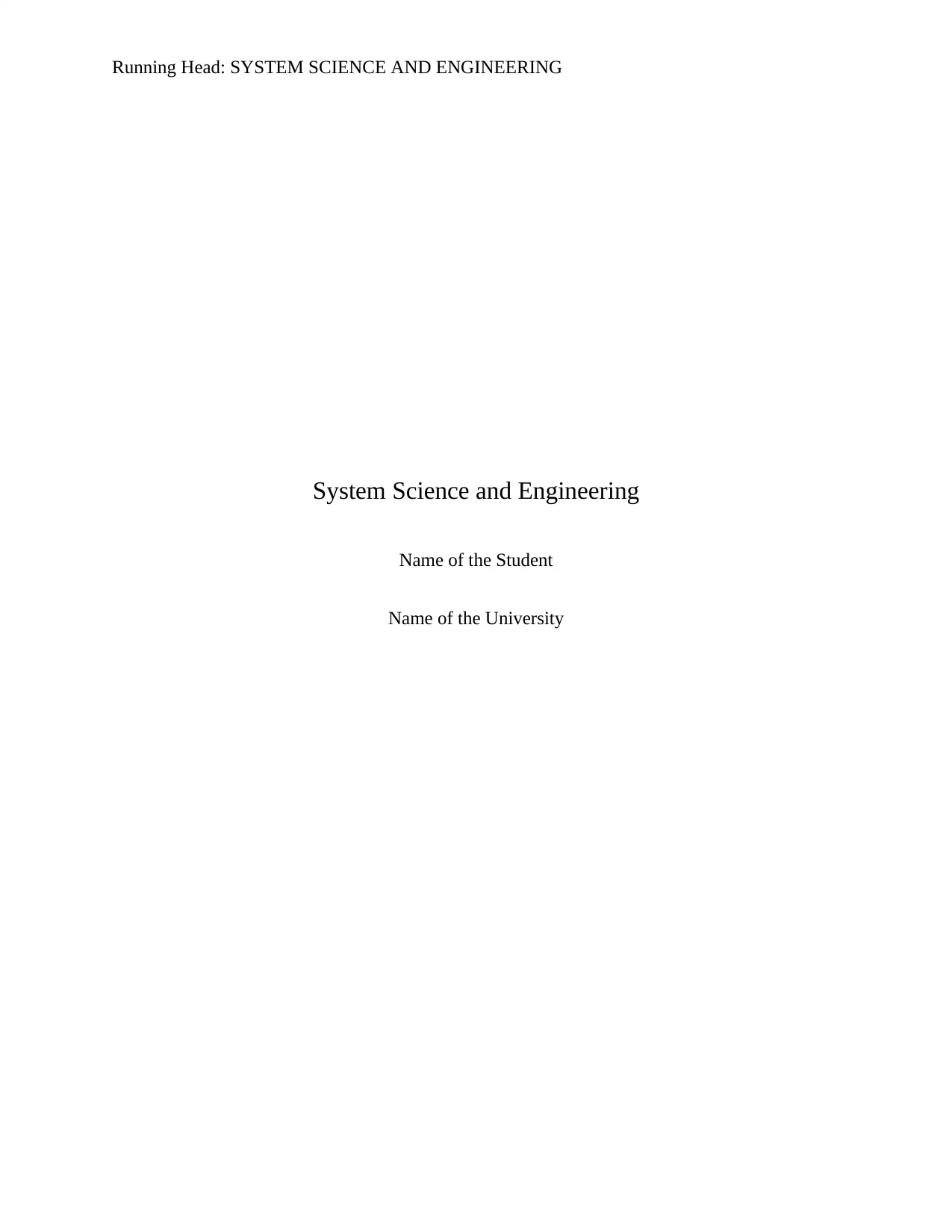
Running Head: SYSTEM SCIENCE AND ENGINEERING
System Science and Engineering
Name of the Student
Name of the University
System Science and Engineering
Name of the Student
Name of the University
Secure Best Marks with AI Grader
Need help grading? Try our AI Grader for instant feedback on your assignments.
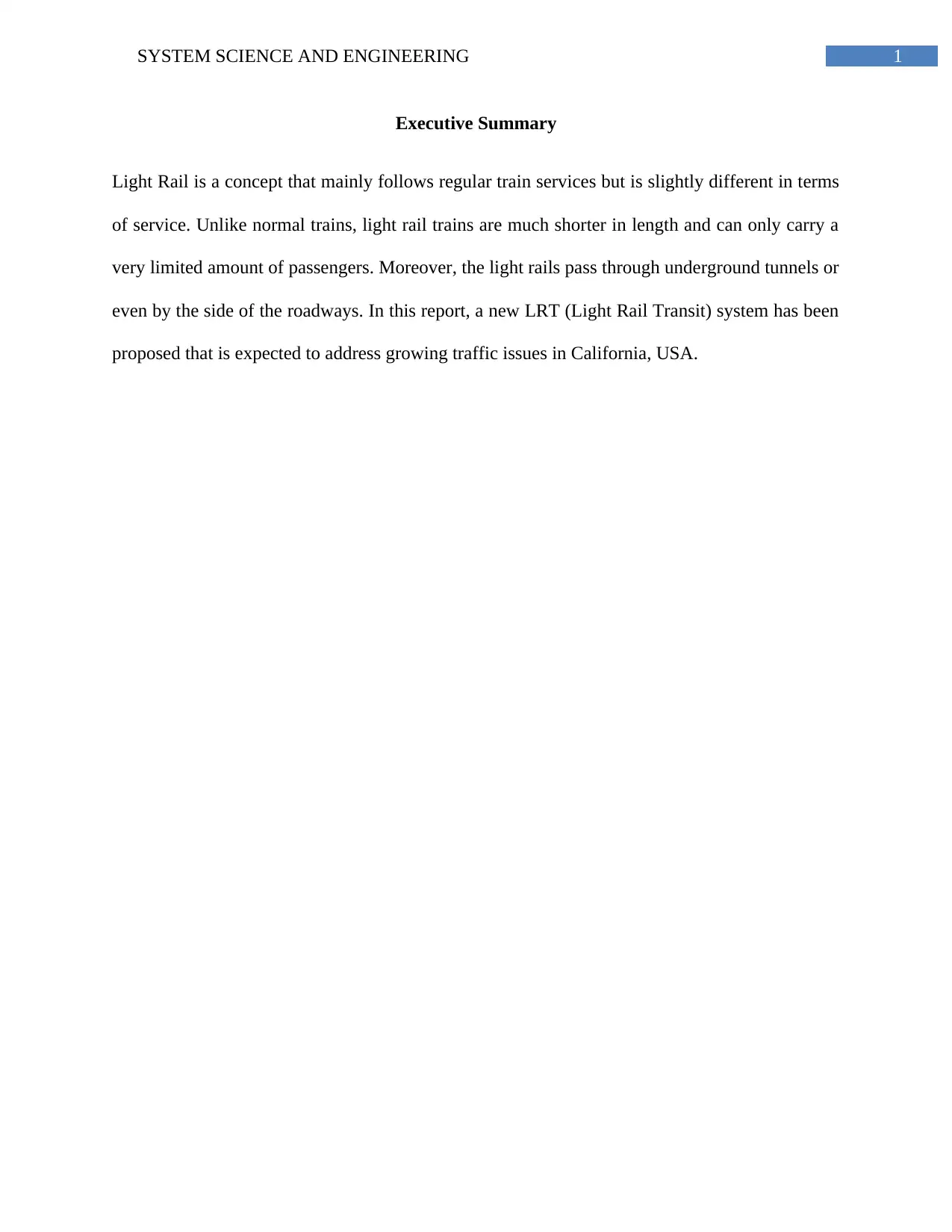
1SYSTEM SCIENCE AND ENGINEERING
Executive Summary
Light Rail is a concept that mainly follows regular train services but is slightly different in terms
of service. Unlike normal trains, light rail trains are much shorter in length and can only carry a
very limited amount of passengers. Moreover, the light rails pass through underground tunnels or
even by the side of the roadways. In this report, a new LRT (Light Rail Transit) system has been
proposed that is expected to address growing traffic issues in California, USA.
Executive Summary
Light Rail is a concept that mainly follows regular train services but is slightly different in terms
of service. Unlike normal trains, light rail trains are much shorter in length and can only carry a
very limited amount of passengers. Moreover, the light rails pass through underground tunnels or
even by the side of the roadways. In this report, a new LRT (Light Rail Transit) system has been
proposed that is expected to address growing traffic issues in California, USA.
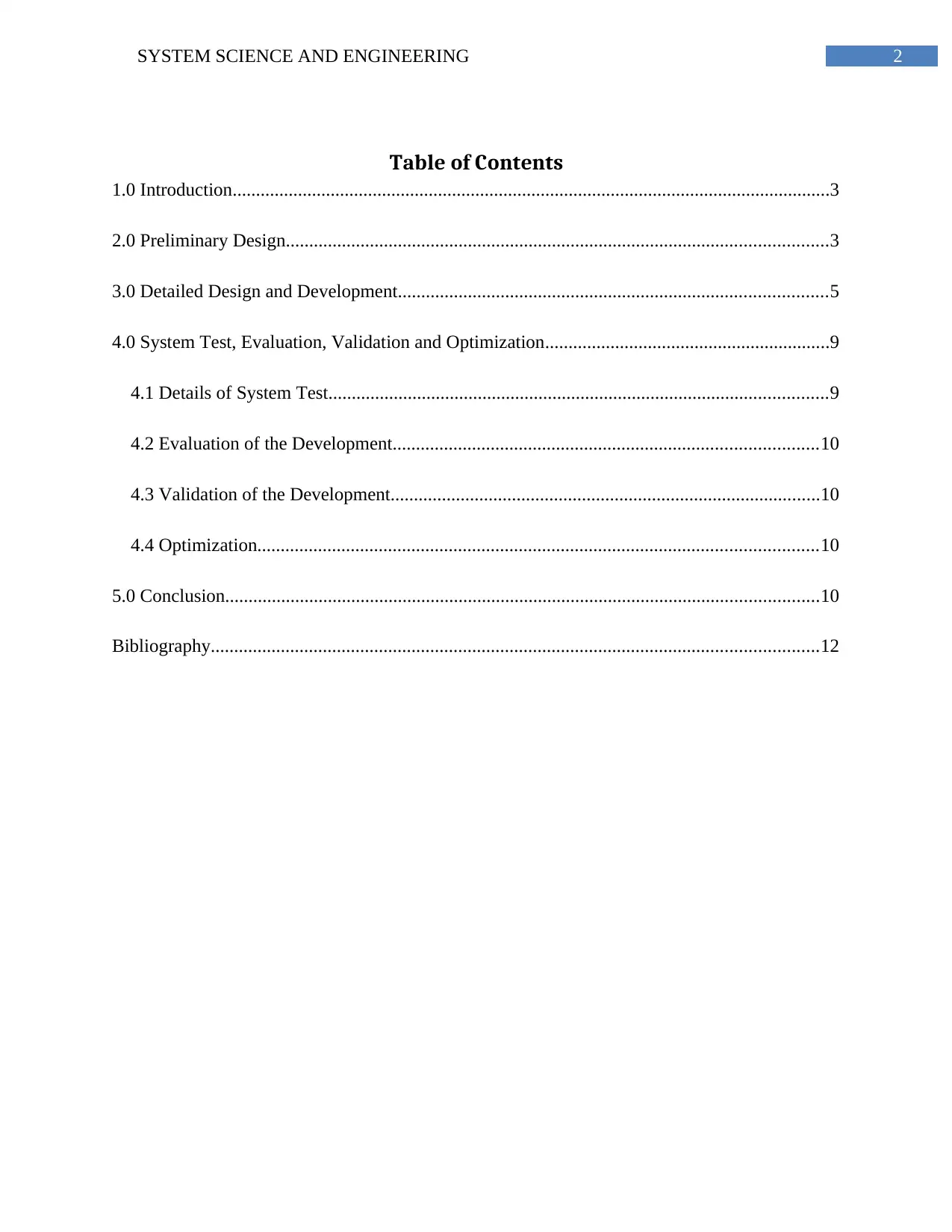
2SYSTEM SCIENCE AND ENGINEERING
Table of Contents
1.0 Introduction................................................................................................................................3
2.0 Preliminary Design....................................................................................................................3
3.0 Detailed Design and Development............................................................................................5
4.0 System Test, Evaluation, Validation and Optimization.............................................................9
4.1 Details of System Test...........................................................................................................9
4.2 Evaluation of the Development...........................................................................................10
4.3 Validation of the Development............................................................................................10
4.4 Optimization........................................................................................................................10
5.0 Conclusion...............................................................................................................................10
Bibliography..................................................................................................................................12
Table of Contents
1.0 Introduction................................................................................................................................3
2.0 Preliminary Design....................................................................................................................3
3.0 Detailed Design and Development............................................................................................5
4.0 System Test, Evaluation, Validation and Optimization.............................................................9
4.1 Details of System Test...........................................................................................................9
4.2 Evaluation of the Development...........................................................................................10
4.3 Validation of the Development............................................................................................10
4.4 Optimization........................................................................................................................10
5.0 Conclusion...............................................................................................................................10
Bibliography..................................................................................................................................12
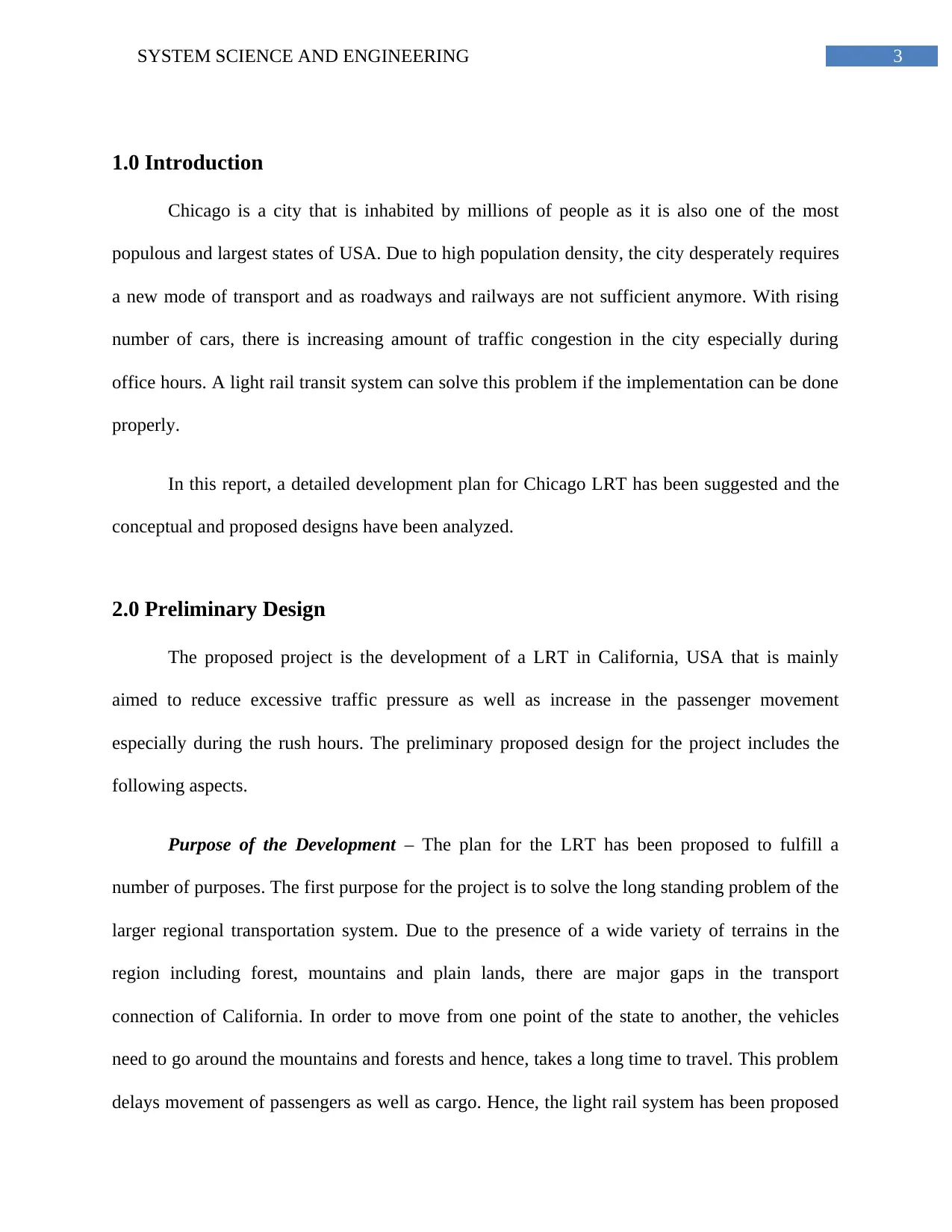
3SYSTEM SCIENCE AND ENGINEERING
1.0 Introduction
Chicago is a city that is inhabited by millions of people as it is also one of the most
populous and largest states of USA. Due to high population density, the city desperately requires
a new mode of transport and as roadways and railways are not sufficient anymore. With rising
number of cars, there is increasing amount of traffic congestion in the city especially during
office hours. A light rail transit system can solve this problem if the implementation can be done
properly.
In this report, a detailed development plan for Chicago LRT has been suggested and the
conceptual and proposed designs have been analyzed.
2.0 Preliminary Design
The proposed project is the development of a LRT in California, USA that is mainly
aimed to reduce excessive traffic pressure as well as increase in the passenger movement
especially during the rush hours. The preliminary proposed design for the project includes the
following aspects.
Purpose of the Development – The plan for the LRT has been proposed to fulfill a
number of purposes. The first purpose for the project is to solve the long standing problem of the
larger regional transportation system. Due to the presence of a wide variety of terrains in the
region including forest, mountains and plain lands, there are major gaps in the transport
connection of California. In order to move from one point of the state to another, the vehicles
need to go around the mountains and forests and hence, takes a long time to travel. This problem
delays movement of passengers as well as cargo. Hence, the light rail system has been proposed
1.0 Introduction
Chicago is a city that is inhabited by millions of people as it is also one of the most
populous and largest states of USA. Due to high population density, the city desperately requires
a new mode of transport and as roadways and railways are not sufficient anymore. With rising
number of cars, there is increasing amount of traffic congestion in the city especially during
office hours. A light rail transit system can solve this problem if the implementation can be done
properly.
In this report, a detailed development plan for Chicago LRT has been suggested and the
conceptual and proposed designs have been analyzed.
2.0 Preliminary Design
The proposed project is the development of a LRT in California, USA that is mainly
aimed to reduce excessive traffic pressure as well as increase in the passenger movement
especially during the rush hours. The preliminary proposed design for the project includes the
following aspects.
Purpose of the Development – The plan for the LRT has been proposed to fulfill a
number of purposes. The first purpose for the project is to solve the long standing problem of the
larger regional transportation system. Due to the presence of a wide variety of terrains in the
region including forest, mountains and plain lands, there are major gaps in the transport
connection of California. In order to move from one point of the state to another, the vehicles
need to go around the mountains and forests and hence, takes a long time to travel. This problem
delays movement of passengers as well as cargo. Hence, the light rail system has been proposed
Secure Best Marks with AI Grader
Need help grading? Try our AI Grader for instant feedback on your assignments.
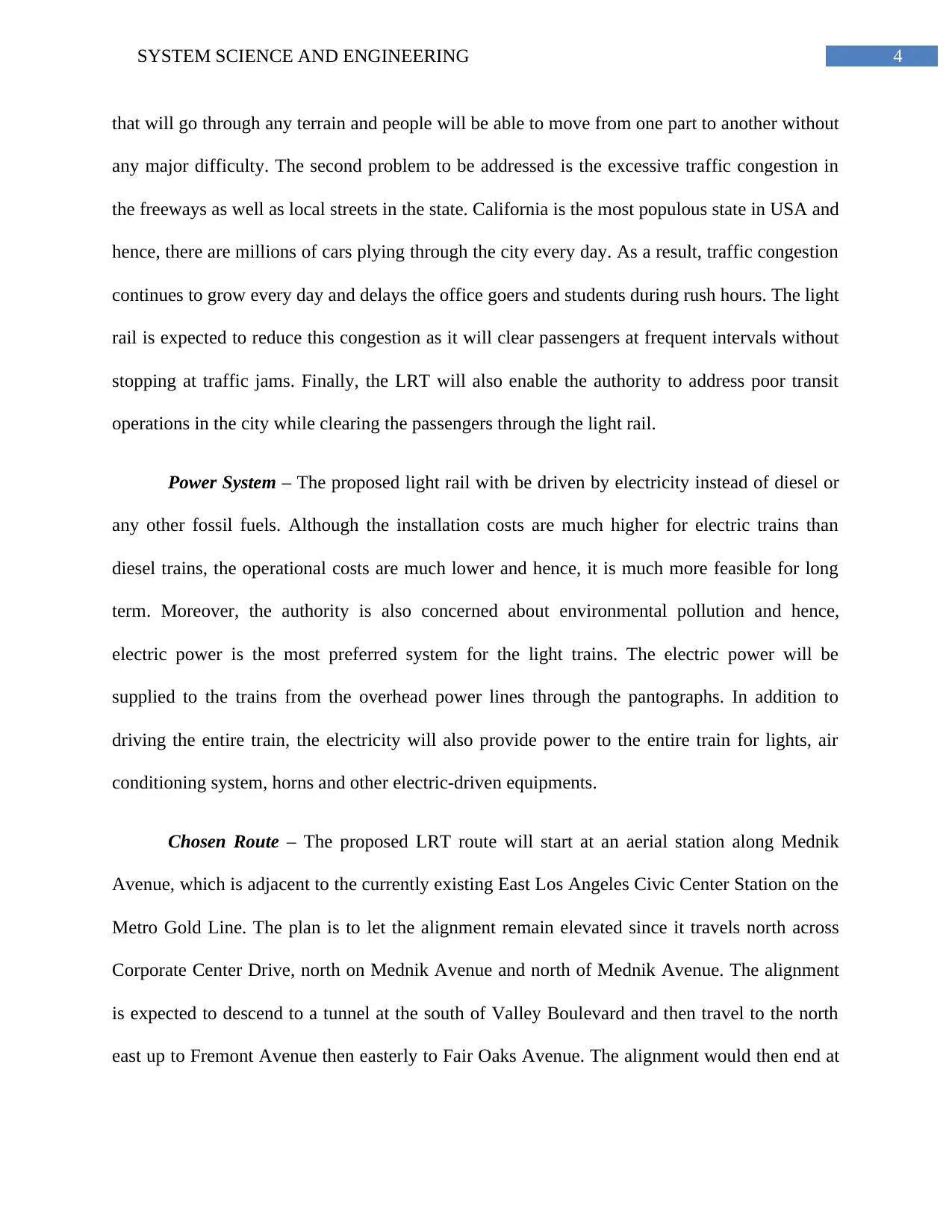
4SYSTEM SCIENCE AND ENGINEERING
that will go through any terrain and people will be able to move from one part to another without
any major difficulty. The second problem to be addressed is the excessive traffic congestion in
the freeways as well as local streets in the state. California is the most populous state in USA and
hence, there are millions of cars plying through the city every day. As a result, traffic congestion
continues to grow every day and delays the office goers and students during rush hours. The light
rail is expected to reduce this congestion as it will clear passengers at frequent intervals without
stopping at traffic jams. Finally, the LRT will also enable the authority to address poor transit
operations in the city while clearing the passengers through the light rail.
Power System – The proposed light rail with be driven by electricity instead of diesel or
any other fossil fuels. Although the installation costs are much higher for electric trains than
diesel trains, the operational costs are much lower and hence, it is much more feasible for long
term. Moreover, the authority is also concerned about environmental pollution and hence,
electric power is the most preferred system for the light trains. The electric power will be
supplied to the trains from the overhead power lines through the pantographs. In addition to
driving the entire train, the electricity will also provide power to the entire train for lights, air
conditioning system, horns and other electric-driven equipments.
Chosen Route – The proposed LRT route will start at an aerial station along Mednik
Avenue, which is adjacent to the currently existing East Los Angeles Civic Center Station on the
Metro Gold Line. The plan is to let the alignment remain elevated since it travels north across
Corporate Center Drive, north on Mednik Avenue and north of Mednik Avenue. The alignment
is expected to descend to a tunnel at the south of Valley Boulevard and then travel to the north
east up to Fremont Avenue then easterly to Fair Oaks Avenue. The alignment would then end at
that will go through any terrain and people will be able to move from one part to another without
any major difficulty. The second problem to be addressed is the excessive traffic congestion in
the freeways as well as local streets in the state. California is the most populous state in USA and
hence, there are millions of cars plying through the city every day. As a result, traffic congestion
continues to grow every day and delays the office goers and students during rush hours. The light
rail is expected to reduce this congestion as it will clear passengers at frequent intervals without
stopping at traffic jams. Finally, the LRT will also enable the authority to address poor transit
operations in the city while clearing the passengers through the light rail.
Power System – The proposed light rail with be driven by electricity instead of diesel or
any other fossil fuels. Although the installation costs are much higher for electric trains than
diesel trains, the operational costs are much lower and hence, it is much more feasible for long
term. Moreover, the authority is also concerned about environmental pollution and hence,
electric power is the most preferred system for the light trains. The electric power will be
supplied to the trains from the overhead power lines through the pantographs. In addition to
driving the entire train, the electricity will also provide power to the entire train for lights, air
conditioning system, horns and other electric-driven equipments.
Chosen Route – The proposed LRT route will start at an aerial station along Mednik
Avenue, which is adjacent to the currently existing East Los Angeles Civic Center Station on the
Metro Gold Line. The plan is to let the alignment remain elevated since it travels north across
Corporate Center Drive, north on Mednik Avenue and north of Mednik Avenue. The alignment
is expected to descend to a tunnel at the south of Valley Boulevard and then travel to the north
east up to Fremont Avenue then easterly to Fair Oaks Avenue. The alignment would then end at
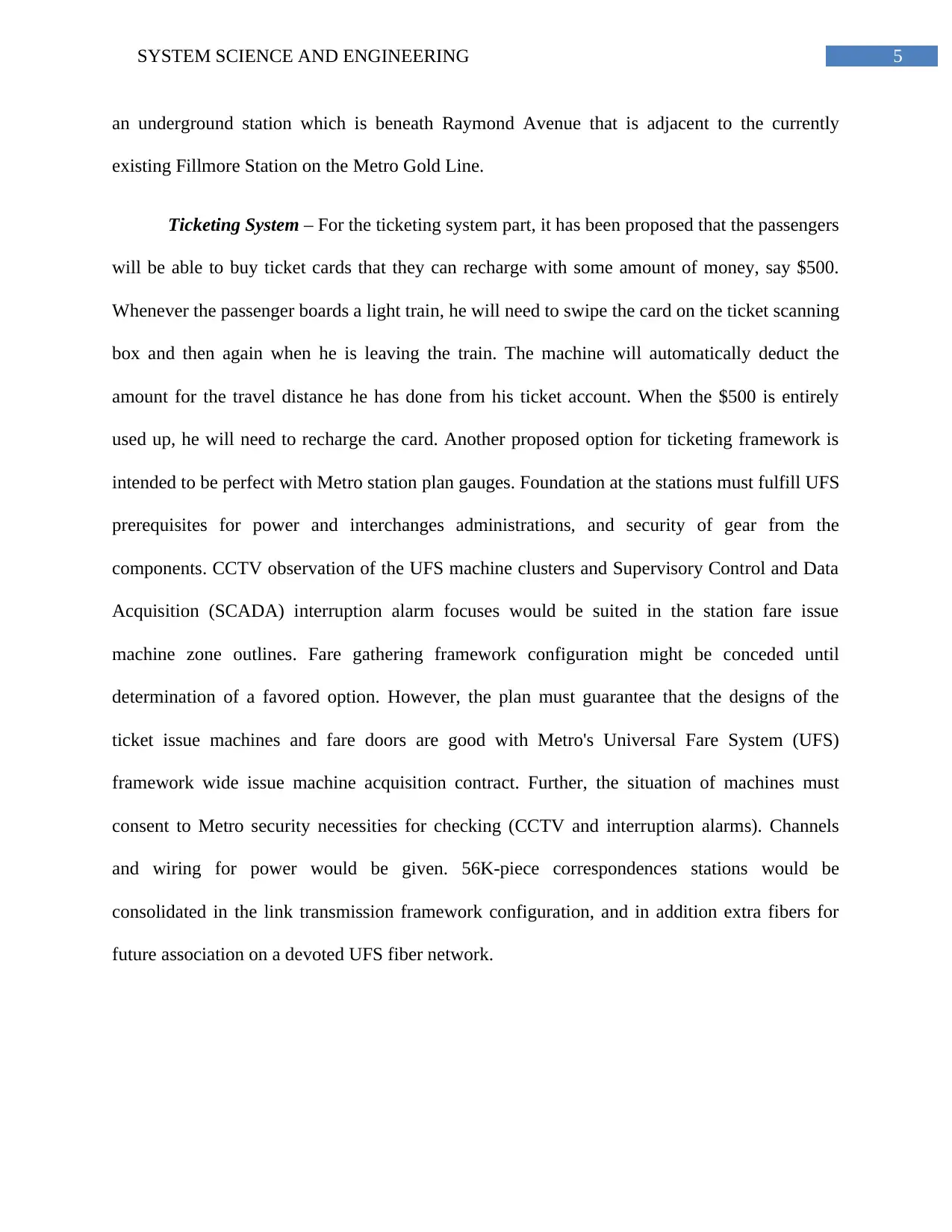
5SYSTEM SCIENCE AND ENGINEERING
an underground station which is beneath Raymond Avenue that is adjacent to the currently
existing Fillmore Station on the Metro Gold Line.
Ticketing System – For the ticketing system part, it has been proposed that the passengers
will be able to buy ticket cards that they can recharge with some amount of money, say $500.
Whenever the passenger boards a light train, he will need to swipe the card on the ticket scanning
box and then again when he is leaving the train. The machine will automatically deduct the
amount for the travel distance he has done from his ticket account. When the $500 is entirely
used up, he will need to recharge the card. Another proposed option for ticketing framework is
intended to be perfect with Metro station plan gauges. Foundation at the stations must fulfill UFS
prerequisites for power and interchanges administrations, and security of gear from the
components. CCTV observation of the UFS machine clusters and Supervisory Control and Data
Acquisition (SCADA) interruption alarm focuses would be suited in the station fare issue
machine zone outlines. Fare gathering framework configuration might be conceded until
determination of a favored option. However, the plan must guarantee that the designs of the
ticket issue machines and fare doors are good with Metro's Universal Fare System (UFS)
framework wide issue machine acquisition contract. Further, the situation of machines must
consent to Metro security necessities for checking (CCTV and interruption alarms). Channels
and wiring for power would be given. 56K-piece correspondences stations would be
consolidated in the link transmission framework configuration, and in addition extra fibers for
future association on a devoted UFS fiber network.
an underground station which is beneath Raymond Avenue that is adjacent to the currently
existing Fillmore Station on the Metro Gold Line.
Ticketing System – For the ticketing system part, it has been proposed that the passengers
will be able to buy ticket cards that they can recharge with some amount of money, say $500.
Whenever the passenger boards a light train, he will need to swipe the card on the ticket scanning
box and then again when he is leaving the train. The machine will automatically deduct the
amount for the travel distance he has done from his ticket account. When the $500 is entirely
used up, he will need to recharge the card. Another proposed option for ticketing framework is
intended to be perfect with Metro station plan gauges. Foundation at the stations must fulfill UFS
prerequisites for power and interchanges administrations, and security of gear from the
components. CCTV observation of the UFS machine clusters and Supervisory Control and Data
Acquisition (SCADA) interruption alarm focuses would be suited in the station fare issue
machine zone outlines. Fare gathering framework configuration might be conceded until
determination of a favored option. However, the plan must guarantee that the designs of the
ticket issue machines and fare doors are good with Metro's Universal Fare System (UFS)
framework wide issue machine acquisition contract. Further, the situation of machines must
consent to Metro security necessities for checking (CCTV and interruption alarms). Channels
and wiring for power would be given. 56K-piece correspondences stations would be
consolidated in the link transmission framework configuration, and in addition extra fibers for
future association on a devoted UFS fiber network.
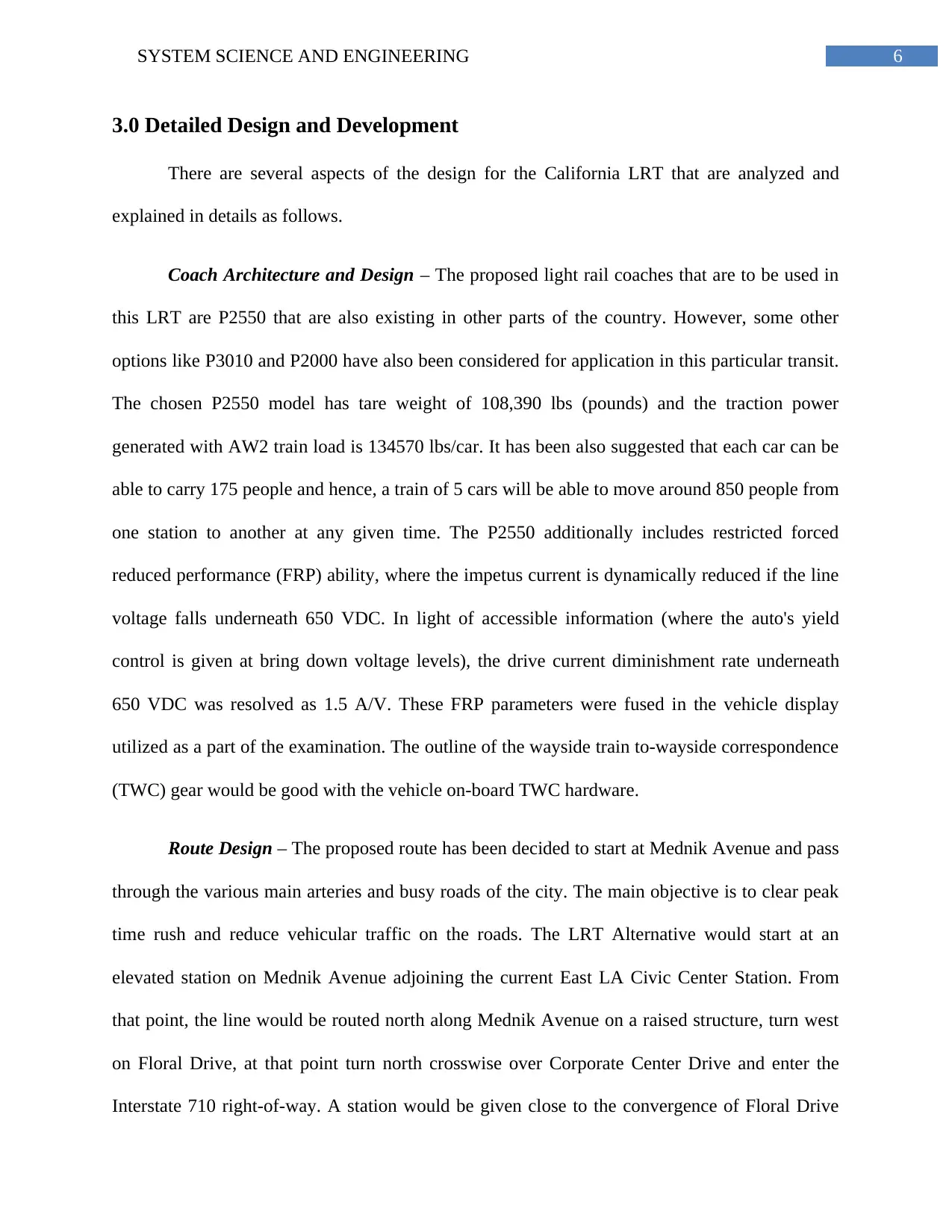
6SYSTEM SCIENCE AND ENGINEERING
3.0 Detailed Design and Development
There are several aspects of the design for the California LRT that are analyzed and
explained in details as follows.
Coach Architecture and Design – The proposed light rail coaches that are to be used in
this LRT are P2550 that are also existing in other parts of the country. However, some other
options like P3010 and P2000 have also been considered for application in this particular transit.
The chosen P2550 model has tare weight of 108,390 lbs (pounds) and the traction power
generated with AW2 train load is 134570 lbs/car. It has been also suggested that each car can be
able to carry 175 people and hence, a train of 5 cars will be able to move around 850 people from
one station to another at any given time. The P2550 additionally includes restricted forced
reduced performance (FRP) ability, where the impetus current is dynamically reduced if the line
voltage falls underneath 650 VDC. In light of accessible information (where the auto's yield
control is given at bring down voltage levels), the drive current diminishment rate underneath
650 VDC was resolved as 1.5 A/V. These FRP parameters were fused in the vehicle display
utilized as a part of the examination. The outline of the wayside train to-wayside correspondence
(TWC) gear would be good with the vehicle on-board TWC hardware.
Route Design – The proposed route has been decided to start at Mednik Avenue and pass
through the various main arteries and busy roads of the city. The main objective is to clear peak
time rush and reduce vehicular traffic on the roads. The LRT Alternative would start at an
elevated station on Mednik Avenue adjoining the current East LA Civic Center Station. From
that point, the line would be routed north along Mednik Avenue on a raised structure, turn west
on Floral Drive, at that point turn north crosswise over Corporate Center Drive and enter the
Interstate 710 right-of-way. A station would be given close to the convergence of Floral Drive
3.0 Detailed Design and Development
There are several aspects of the design for the California LRT that are analyzed and
explained in details as follows.
Coach Architecture and Design – The proposed light rail coaches that are to be used in
this LRT are P2550 that are also existing in other parts of the country. However, some other
options like P3010 and P2000 have also been considered for application in this particular transit.
The chosen P2550 model has tare weight of 108,390 lbs (pounds) and the traction power
generated with AW2 train load is 134570 lbs/car. It has been also suggested that each car can be
able to carry 175 people and hence, a train of 5 cars will be able to move around 850 people from
one station to another at any given time. The P2550 additionally includes restricted forced
reduced performance (FRP) ability, where the impetus current is dynamically reduced if the line
voltage falls underneath 650 VDC. In light of accessible information (where the auto's yield
control is given at bring down voltage levels), the drive current diminishment rate underneath
650 VDC was resolved as 1.5 A/V. These FRP parameters were fused in the vehicle display
utilized as a part of the examination. The outline of the wayside train to-wayside correspondence
(TWC) gear would be good with the vehicle on-board TWC hardware.
Route Design – The proposed route has been decided to start at Mednik Avenue and pass
through the various main arteries and busy roads of the city. The main objective is to clear peak
time rush and reduce vehicular traffic on the roads. The LRT Alternative would start at an
elevated station on Mednik Avenue adjoining the current East LA Civic Center Station. From
that point, the line would be routed north along Mednik Avenue on a raised structure, turn west
on Floral Drive, at that point turn north crosswise over Corporate Center Drive and enter the
Interstate 710 right-of-way. A station would be given close to the convergence of Floral Drive
Paraphrase This Document
Need a fresh take? Get an instant paraphrase of this document with our AI Paraphraser
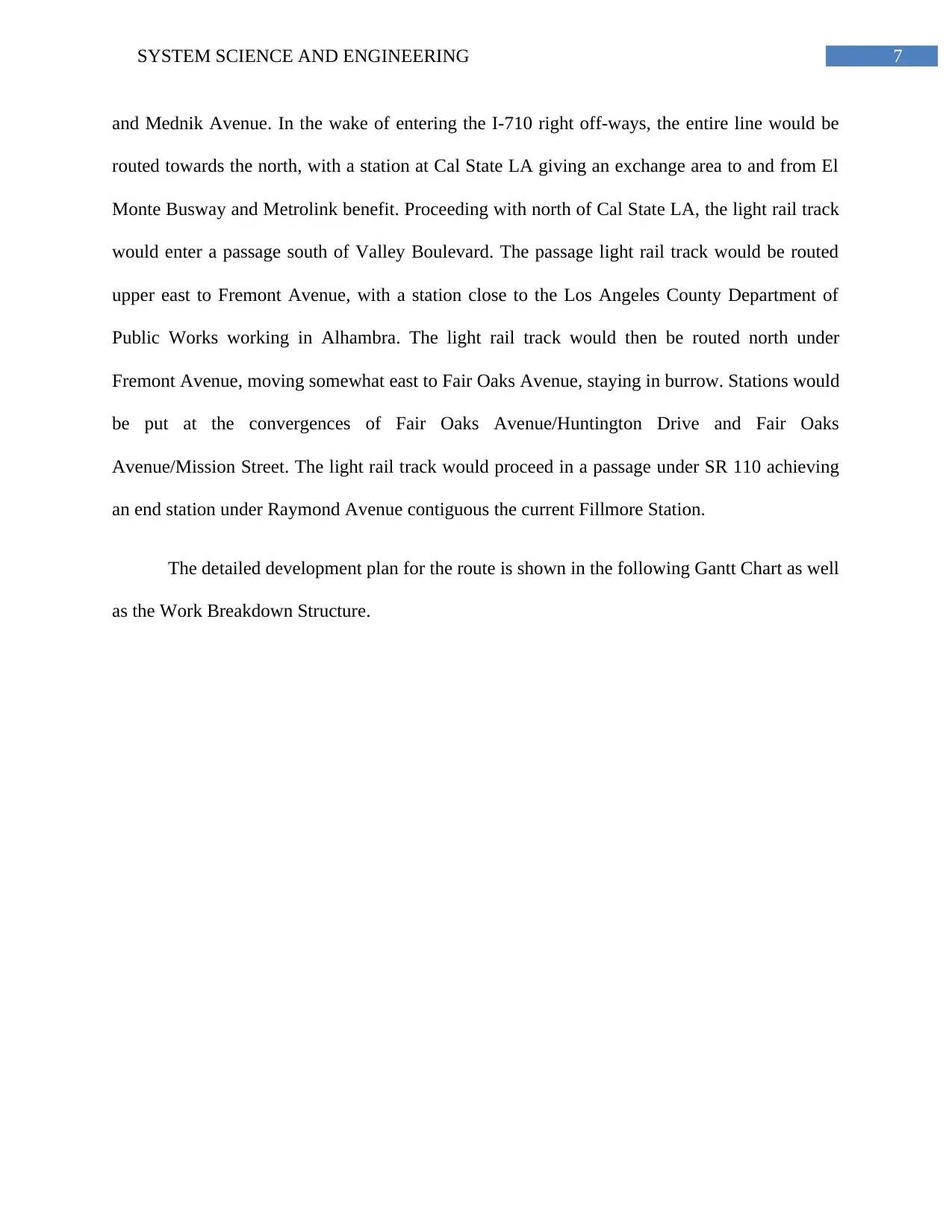
7SYSTEM SCIENCE AND ENGINEERING
and Mednik Avenue. In the wake of entering the I-710 right off-ways, the entire line would be
routed towards the north, with a station at Cal State LA giving an exchange area to and from El
Monte Busway and Metrolink benefit. Proceeding with north of Cal State LA, the light rail track
would enter a passage south of Valley Boulevard. The passage light rail track would be routed
upper east to Fremont Avenue, with a station close to the Los Angeles County Department of
Public Works working in Alhambra. The light rail track would then be routed north under
Fremont Avenue, moving somewhat east to Fair Oaks Avenue, staying in burrow. Stations would
be put at the convergences of Fair Oaks Avenue/Huntington Drive and Fair Oaks
Avenue/Mission Street. The light rail track would proceed in a passage under SR 110 achieving
an end station under Raymond Avenue contiguous the current Fillmore Station.
The detailed development plan for the route is shown in the following Gantt Chart as well
as the Work Breakdown Structure.
and Mednik Avenue. In the wake of entering the I-710 right off-ways, the entire line would be
routed towards the north, with a station at Cal State LA giving an exchange area to and from El
Monte Busway and Metrolink benefit. Proceeding with north of Cal State LA, the light rail track
would enter a passage south of Valley Boulevard. The passage light rail track would be routed
upper east to Fremont Avenue, with a station close to the Los Angeles County Department of
Public Works working in Alhambra. The light rail track would then be routed north under
Fremont Avenue, moving somewhat east to Fair Oaks Avenue, staying in burrow. Stations would
be put at the convergences of Fair Oaks Avenue/Huntington Drive and Fair Oaks
Avenue/Mission Street. The light rail track would proceed in a passage under SR 110 achieving
an end station under Raymond Avenue contiguous the current Fillmore Station.
The detailed development plan for the route is shown in the following Gantt Chart as well
as the Work Breakdown Structure.
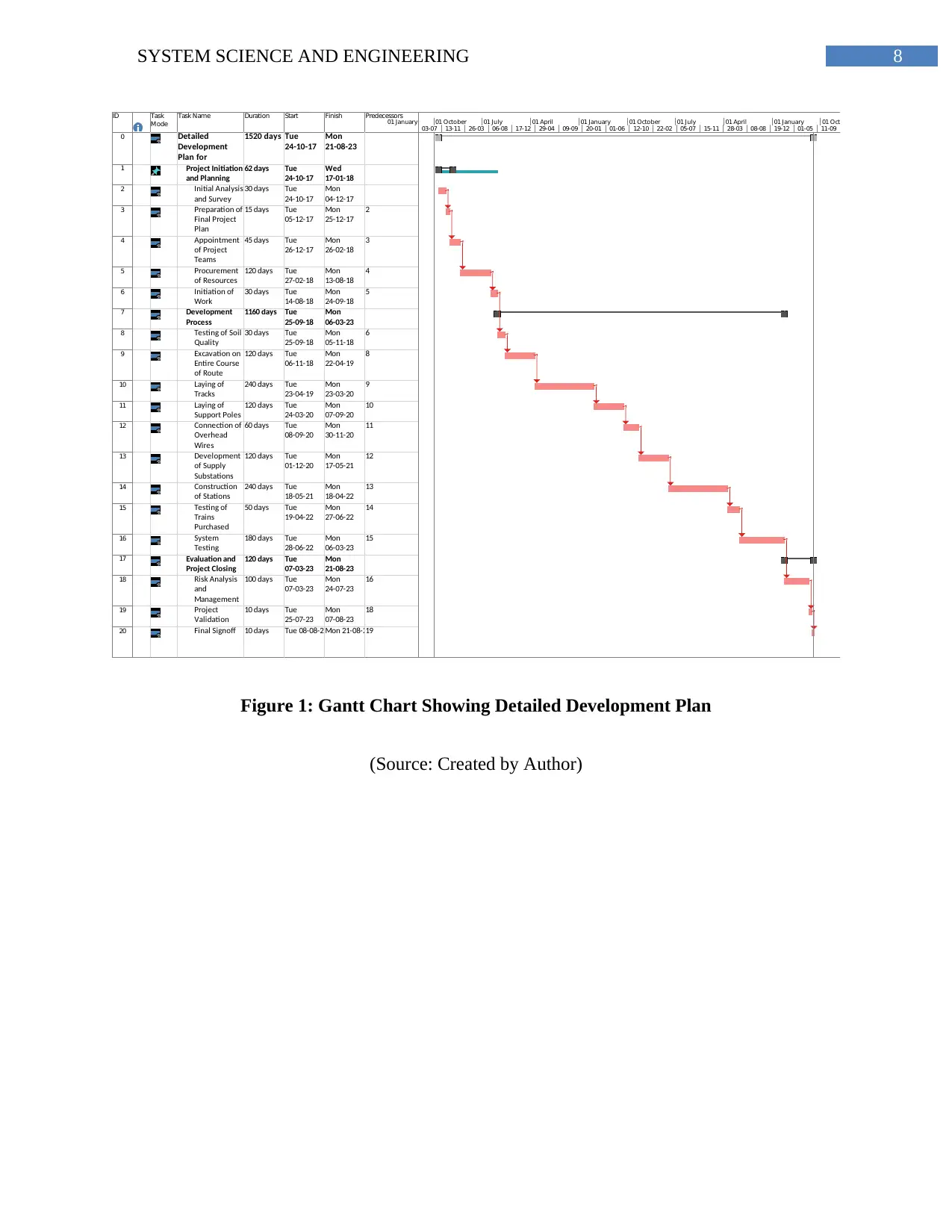
8SYSTEM SCIENCE AND ENGINEERING
ID Task
Mode
Task Name Duration Start Finish Predecessors
0 Detailed
Development
Plan for
California LRT
1520 days Tue
24-10-17
Mon
21-08-23
1 Project Initiation
and Planning
62 days Tue
24-10-17
Wed
17-01-18
2 Initial Analysis
and Survey
30 days Tue
24-10-17
Mon
04-12-17
3 Preparation of
Final Project
Plan
15 days Tue
05-12-17
Mon
25-12-17
2
4 Appointment
of Project
Teams
45 days Tue
26-12-17
Mon
26-02-18
3
5 Procurement
of Resources
120 days Tue
27-02-18
Mon
13-08-18
4
6 Initiation of
Work
30 days Tue
14-08-18
Mon
24-09-18
5
7 Development
Process
1160 days Tue
25-09-18
Mon
06-03-23
8 Testing of Soil
Quality
30 days Tue
25-09-18
Mon
05-11-18
6
9 Excavation on
Entire Course
of Route
120 days Tue
06-11-18
Mon
22-04-19
8
10 Laying of
Tracks
240 days Tue
23-04-19
Mon
23-03-20
9
11 Laying of
Support Poles
120 days Tue
24-03-20
Mon
07-09-20
10
12 Connection of
Overhead
Wires
60 days Tue
08-09-20
Mon
30-11-20
11
13 Development
of Supply
Substations
120 days Tue
01-12-20
Mon
17-05-21
12
14 Construction
of Stations
240 days Tue
18-05-21
Mon
18-04-22
13
15 Testing of
Trains
Purchased
50 days Tue
19-04-22
Mon
27-06-22
14
16 System
Testing
180 days Tue
28-06-22
Mon
06-03-23
15
17 Evaluation and
Project Closing
120 days Tue
07-03-23
Mon
21-08-23
18 Risk Analysis
and
Management
100 days Tue
07-03-23
Mon
24-07-23
16
19 Project
Validation
10 days Tue
25-07-23
Mon
07-08-23
18
20 Final Signoff 10 days Tue 08-08-23Mon 21-08-2319
03-07 13-11 26-03 06-08 17-12 29-04 09-09 20-01 01-06 12-10 22-02 05-07 15-11 28-03 08-08 19-12 01-05 11-09
01 January 01 October 01 July 01 April 01 January 01 October 01 July 01 April 01 January 01 October
Figure 1: Gantt Chart Showing Detailed Development Plan
(Source: Created by Author)
ID Task
Mode
Task Name Duration Start Finish Predecessors
0 Detailed
Development
Plan for
California LRT
1520 days Tue
24-10-17
Mon
21-08-23
1 Project Initiation
and Planning
62 days Tue
24-10-17
Wed
17-01-18
2 Initial Analysis
and Survey
30 days Tue
24-10-17
Mon
04-12-17
3 Preparation of
Final Project
Plan
15 days Tue
05-12-17
Mon
25-12-17
2
4 Appointment
of Project
Teams
45 days Tue
26-12-17
Mon
26-02-18
3
5 Procurement
of Resources
120 days Tue
27-02-18
Mon
13-08-18
4
6 Initiation of
Work
30 days Tue
14-08-18
Mon
24-09-18
5
7 Development
Process
1160 days Tue
25-09-18
Mon
06-03-23
8 Testing of Soil
Quality
30 days Tue
25-09-18
Mon
05-11-18
6
9 Excavation on
Entire Course
of Route
120 days Tue
06-11-18
Mon
22-04-19
8
10 Laying of
Tracks
240 days Tue
23-04-19
Mon
23-03-20
9
11 Laying of
Support Poles
120 days Tue
24-03-20
Mon
07-09-20
10
12 Connection of
Overhead
Wires
60 days Tue
08-09-20
Mon
30-11-20
11
13 Development
of Supply
Substations
120 days Tue
01-12-20
Mon
17-05-21
12
14 Construction
of Stations
240 days Tue
18-05-21
Mon
18-04-22
13
15 Testing of
Trains
Purchased
50 days Tue
19-04-22
Mon
27-06-22
14
16 System
Testing
180 days Tue
28-06-22
Mon
06-03-23
15
17 Evaluation and
Project Closing
120 days Tue
07-03-23
Mon
21-08-23
18 Risk Analysis
and
Management
100 days Tue
07-03-23
Mon
24-07-23
16
19 Project
Validation
10 days Tue
25-07-23
Mon
07-08-23
18
20 Final Signoff 10 days Tue 08-08-23Mon 21-08-2319
03-07 13-11 26-03 06-08 17-12 29-04 09-09 20-01 01-06 12-10 22-02 05-07 15-11 28-03 08-08 19-12 01-05 11-09
01 January 01 October 01 July 01 April 01 January 01 October 01 July 01 April 01 January 01 October
Figure 1: Gantt Chart Showing Detailed Development Plan
(Source: Created by Author)
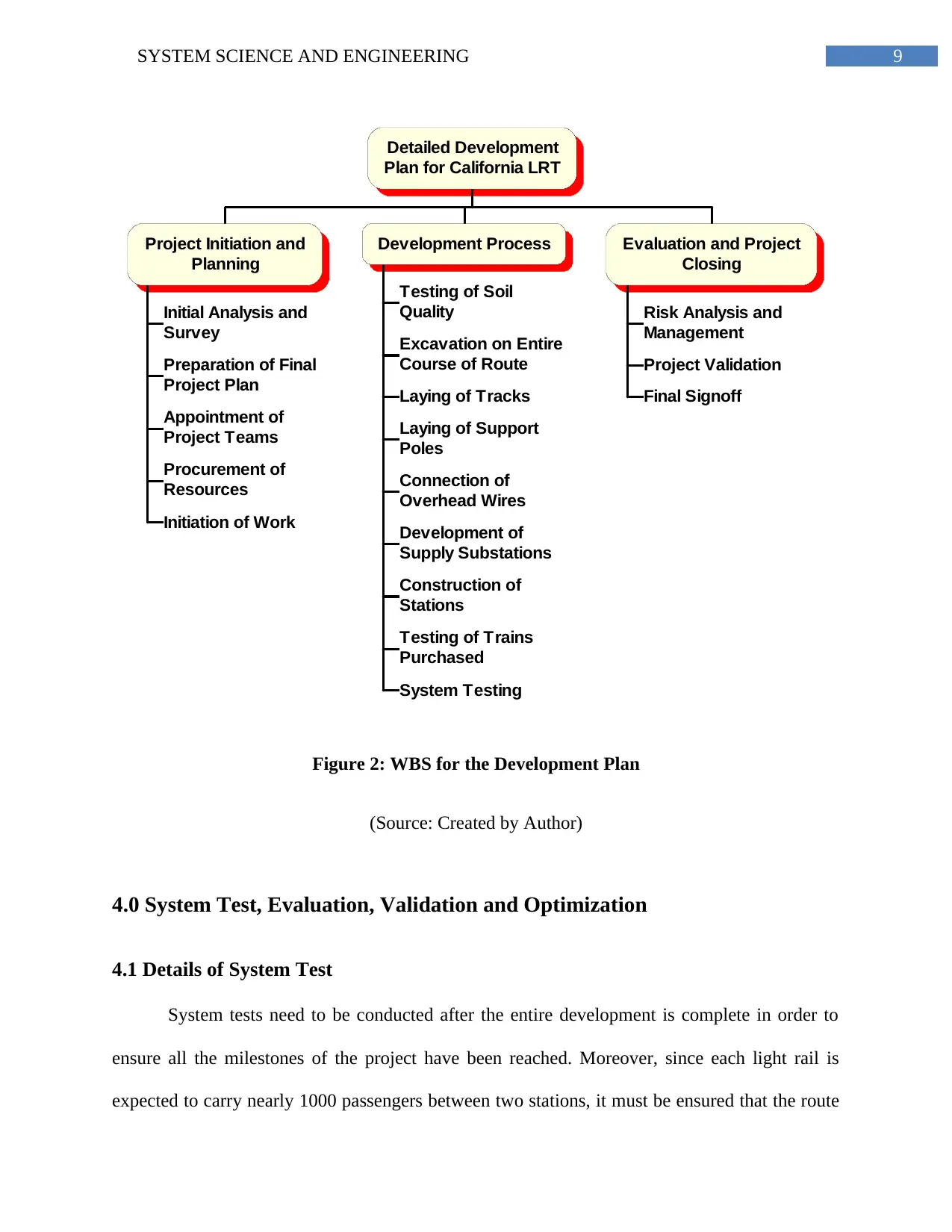
9SYSTEM SCIENCE AND ENGINEERING
Detailed Development
Plan for California LRT
Project Initiation and
Planning
Initial Analysis and
Survey
Preparation of Final
Project Plan
Appointment of
Project Teams
Procurement of
Resources
Initiation of Work
Development Process
Testing of Soil
Quality
Excavation on Entire
Course of Route
Laying of Tracks
Laying of Support
Poles
Connection of
Overhead Wires
Development of
Supply Substations
Construction of
Stations
Testing of Trains
Purchased
System Testing
Evaluation and Project
Closing
Risk Analysis and
Management
Project Validation
Final Signoff
Figure 2: WBS for the Development Plan
(Source: Created by Author)
4.0 System Test, Evaluation, Validation and Optimization
4.1 Details of System Test
System tests need to be conducted after the entire development is complete in order to
ensure all the milestones of the project have been reached. Moreover, since each light rail is
expected to carry nearly 1000 passengers between two stations, it must be ensured that the route
Detailed Development
Plan for California LRT
Project Initiation and
Planning
Initial Analysis and
Survey
Preparation of Final
Project Plan
Appointment of
Project Teams
Procurement of
Resources
Initiation of Work
Development Process
Testing of Soil
Quality
Excavation on Entire
Course of Route
Laying of Tracks
Laying of Support
Poles
Connection of
Overhead Wires
Development of
Supply Substations
Construction of
Stations
Testing of Trains
Purchased
System Testing
Evaluation and Project
Closing
Risk Analysis and
Management
Project Validation
Final Signoff
Figure 2: WBS for the Development Plan
(Source: Created by Author)
4.0 System Test, Evaluation, Validation and Optimization
4.1 Details of System Test
System tests need to be conducted after the entire development is complete in order to
ensure all the milestones of the project have been reached. Moreover, since each light rail is
expected to carry nearly 1000 passengers between two stations, it must be ensured that the route
Secure Best Marks with AI Grader
Need help grading? Try our AI Grader for instant feedback on your assignments.
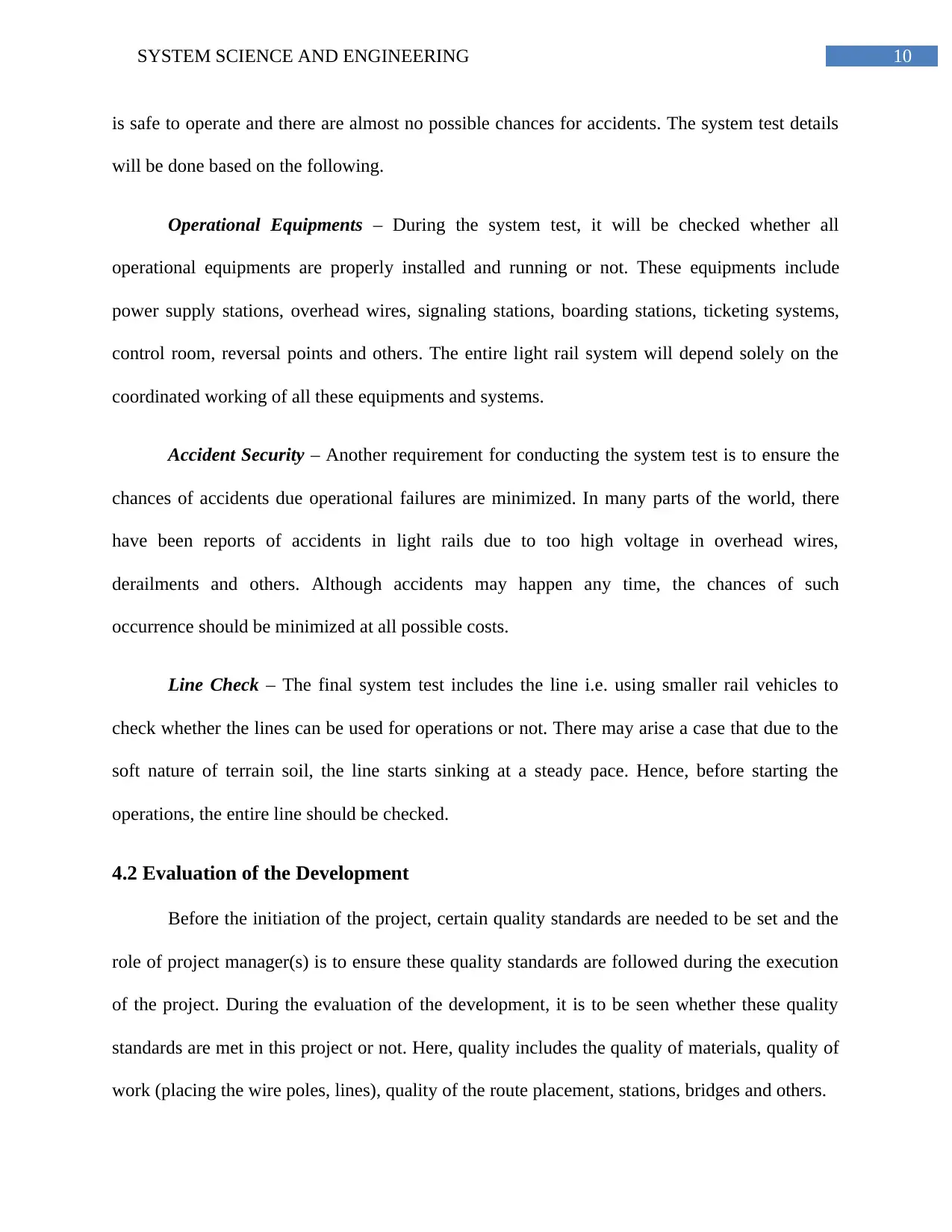
10SYSTEM SCIENCE AND ENGINEERING
is safe to operate and there are almost no possible chances for accidents. The system test details
will be done based on the following.
Operational Equipments – During the system test, it will be checked whether all
operational equipments are properly installed and running or not. These equipments include
power supply stations, overhead wires, signaling stations, boarding stations, ticketing systems,
control room, reversal points and others. The entire light rail system will depend solely on the
coordinated working of all these equipments and systems.
Accident Security – Another requirement for conducting the system test is to ensure the
chances of accidents due operational failures are minimized. In many parts of the world, there
have been reports of accidents in light rails due to too high voltage in overhead wires,
derailments and others. Although accidents may happen any time, the chances of such
occurrence should be minimized at all possible costs.
Line Check – The final system test includes the line i.e. using smaller rail vehicles to
check whether the lines can be used for operations or not. There may arise a case that due to the
soft nature of terrain soil, the line starts sinking at a steady pace. Hence, before starting the
operations, the entire line should be checked.
4.2 Evaluation of the Development
Before the initiation of the project, certain quality standards are needed to be set and the
role of project manager(s) is to ensure these quality standards are followed during the execution
of the project. During the evaluation of the development, it is to be seen whether these quality
standards are met in this project or not. Here, quality includes the quality of materials, quality of
work (placing the wire poles, lines), quality of the route placement, stations, bridges and others.
is safe to operate and there are almost no possible chances for accidents. The system test details
will be done based on the following.
Operational Equipments – During the system test, it will be checked whether all
operational equipments are properly installed and running or not. These equipments include
power supply stations, overhead wires, signaling stations, boarding stations, ticketing systems,
control room, reversal points and others. The entire light rail system will depend solely on the
coordinated working of all these equipments and systems.
Accident Security – Another requirement for conducting the system test is to ensure the
chances of accidents due operational failures are minimized. In many parts of the world, there
have been reports of accidents in light rails due to too high voltage in overhead wires,
derailments and others. Although accidents may happen any time, the chances of such
occurrence should be minimized at all possible costs.
Line Check – The final system test includes the line i.e. using smaller rail vehicles to
check whether the lines can be used for operations or not. There may arise a case that due to the
soft nature of terrain soil, the line starts sinking at a steady pace. Hence, before starting the
operations, the entire line should be checked.
4.2 Evaluation of the Development
Before the initiation of the project, certain quality standards are needed to be set and the
role of project manager(s) is to ensure these quality standards are followed during the execution
of the project. During the evaluation of the development, it is to be seen whether these quality
standards are met in this project or not. Here, quality includes the quality of materials, quality of
work (placing the wire poles, lines), quality of the route placement, stations, bridges and others.

11SYSTEM SCIENCE AND ENGINEERING
4.3 Validation of the Development
The validation of the development will be approved by the project manager(s) once it is
ensured that there no loopholes in the quality and safety standards used in the project. The
validation is done after all the stakeholders agree about the final outcome of the project and all
the system test results come out to be positive.
4.4 Optimization
System optimization plan is carried in order to optimize the system even further. The
optimization plan for this project includes additional of air conditioning system inside the rail
cars (and also auxiliary ventilation system in case the A.C. stops working), use of solar energy to
reduce costs of electrical power, use of more high speed trains and others. However, all these
plans will be executed based on their economical feasibility for this development.
5.0 Conclusion
In this report, a detailed development plan for Chicago LRT has been suggested. The
light rail system has been proposed that will go through any terrain in the California state and
people will be able to move from one part to another without any major difficulty. The new LRT
is also proposed to address excessive traffic congestion in the freeways as well as local streets in
the state. The route details as well as the plan for the development of the light rail systems and
the railcars to be used have been discussed in this report.
4.3 Validation of the Development
The validation of the development will be approved by the project manager(s) once it is
ensured that there no loopholes in the quality and safety standards used in the project. The
validation is done after all the stakeholders agree about the final outcome of the project and all
the system test results come out to be positive.
4.4 Optimization
System optimization plan is carried in order to optimize the system even further. The
optimization plan for this project includes additional of air conditioning system inside the rail
cars (and also auxiliary ventilation system in case the A.C. stops working), use of solar energy to
reduce costs of electrical power, use of more high speed trains and others. However, all these
plans will be executed based on their economical feasibility for this development.
5.0 Conclusion
In this report, a detailed development plan for Chicago LRT has been suggested. The
light rail system has been proposed that will go through any terrain in the California state and
people will be able to move from one part to another without any major difficulty. The new LRT
is also proposed to address excessive traffic congestion in the freeways as well as local streets in
the state. The route details as well as the plan for the development of the light rail systems and
the railcars to be used have been discussed in this report.
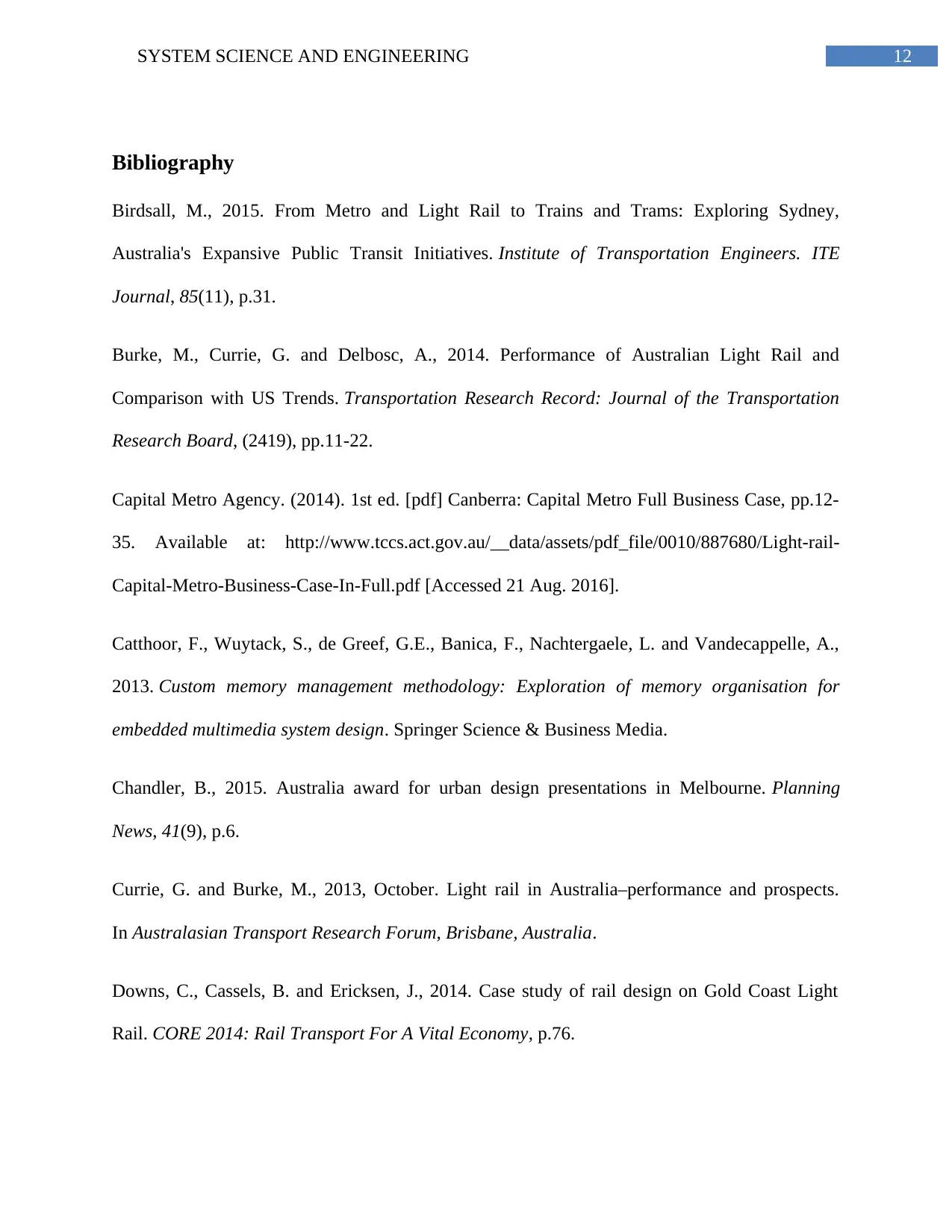
12SYSTEM SCIENCE AND ENGINEERING
Bibliography
Birdsall, M., 2015. From Metro and Light Rail to Trains and Trams: Exploring Sydney,
Australia's Expansive Public Transit Initiatives. Institute of Transportation Engineers. ITE
Journal, 85(11), p.31.
Burke, M., Currie, G. and Delbosc, A., 2014. Performance of Australian Light Rail and
Comparison with US Trends. Transportation Research Record: Journal of the Transportation
Research Board, (2419), pp.11-22.
Capital Metro Agency. (2014). 1st ed. [pdf] Canberra: Capital Metro Full Business Case, pp.12-
35. Available at: http://www.tccs.act.gov.au/__data/assets/pdf_file/0010/887680/Light-rail-
Capital-Metro-Business-Case-In-Full.pdf [Accessed 21 Aug. 2016].
Catthoor, F., Wuytack, S., de Greef, G.E., Banica, F., Nachtergaele, L. and Vandecappelle, A.,
2013. Custom memory management methodology: Exploration of memory organisation for
embedded multimedia system design. Springer Science & Business Media.
Chandler, B., 2015. Australia award for urban design presentations in Melbourne. Planning
News, 41(9), p.6.
Currie, G. and Burke, M., 2013, October. Light rail in Australia–performance and prospects.
In Australasian Transport Research Forum, Brisbane, Australia.
Downs, C., Cassels, B. and Ericksen, J., 2014. Case study of rail design on Gold Coast Light
Rail. CORE 2014: Rail Transport For A Vital Economy, p.76.
Bibliography
Birdsall, M., 2015. From Metro and Light Rail to Trains and Trams: Exploring Sydney,
Australia's Expansive Public Transit Initiatives. Institute of Transportation Engineers. ITE
Journal, 85(11), p.31.
Burke, M., Currie, G. and Delbosc, A., 2014. Performance of Australian Light Rail and
Comparison with US Trends. Transportation Research Record: Journal of the Transportation
Research Board, (2419), pp.11-22.
Capital Metro Agency. (2014). 1st ed. [pdf] Canberra: Capital Metro Full Business Case, pp.12-
35. Available at: http://www.tccs.act.gov.au/__data/assets/pdf_file/0010/887680/Light-rail-
Capital-Metro-Business-Case-In-Full.pdf [Accessed 21 Aug. 2016].
Catthoor, F., Wuytack, S., de Greef, G.E., Banica, F., Nachtergaele, L. and Vandecappelle, A.,
2013. Custom memory management methodology: Exploration of memory organisation for
embedded multimedia system design. Springer Science & Business Media.
Chandler, B., 2015. Australia award for urban design presentations in Melbourne. Planning
News, 41(9), p.6.
Currie, G. and Burke, M., 2013, October. Light rail in Australia–performance and prospects.
In Australasian Transport Research Forum, Brisbane, Australia.
Downs, C., Cassels, B. and Ericksen, J., 2014. Case study of rail design on Gold Coast Light
Rail. CORE 2014: Rail Transport For A Vital Economy, p.76.
Paraphrase This Document
Need a fresh take? Get an instant paraphrase of this document with our AI Paraphraser
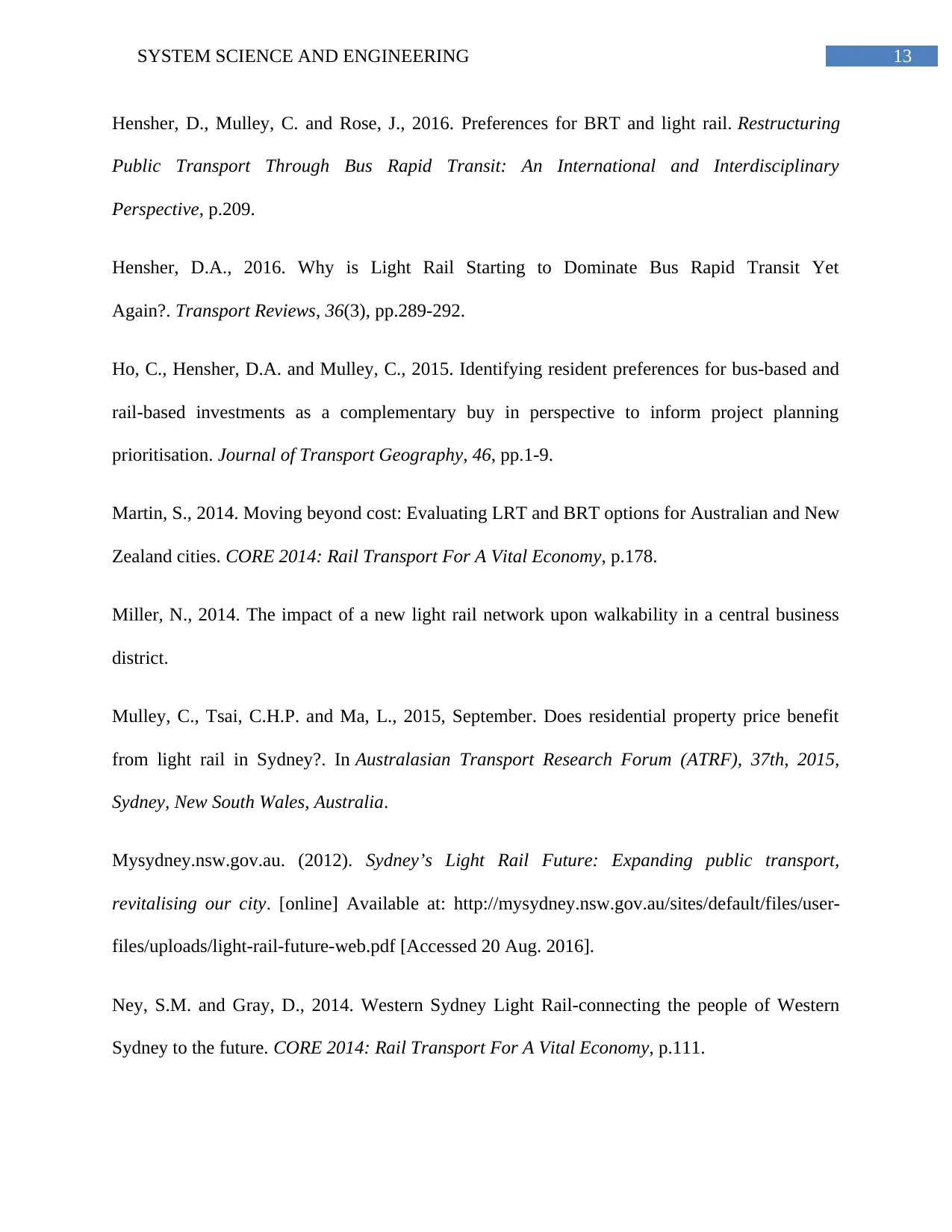
13SYSTEM SCIENCE AND ENGINEERING
Hensher, D., Mulley, C. and Rose, J., 2016. Preferences for BRT and light rail. Restructuring
Public Transport Through Bus Rapid Transit: An International and Interdisciplinary
Perspective, p.209.
Hensher, D.A., 2016. Why is Light Rail Starting to Dominate Bus Rapid Transit Yet
Again?. Transport Reviews, 36(3), pp.289-292.
Ho, C., Hensher, D.A. and Mulley, C., 2015. Identifying resident preferences for bus-based and
rail-based investments as a complementary buy in perspective to inform project planning
prioritisation. Journal of Transport Geography, 46, pp.1-9.
Martin, S., 2014. Moving beyond cost: Evaluating LRT and BRT options for Australian and New
Zealand cities. CORE 2014: Rail Transport For A Vital Economy, p.178.
Miller, N., 2014. The impact of a new light rail network upon walkability in a central business
district.
Mulley, C., Tsai, C.H.P. and Ma, L., 2015, September. Does residential property price benefit
from light rail in Sydney?. In Australasian Transport Research Forum (ATRF), 37th, 2015,
Sydney, New South Wales, Australia.
Mysydney.nsw.gov.au. (2012). Sydney’s Light Rail Future: Expanding public transport,
revitalising our city. [online] Available at: http://mysydney.nsw.gov.au/sites/default/files/user-
files/uploads/light-rail-future-web.pdf [Accessed 20 Aug. 2016].
Ney, S.M. and Gray, D., 2014. Western Sydney Light Rail-connecting the people of Western
Sydney to the future. CORE 2014: Rail Transport For A Vital Economy, p.111.
Hensher, D., Mulley, C. and Rose, J., 2016. Preferences for BRT and light rail. Restructuring
Public Transport Through Bus Rapid Transit: An International and Interdisciplinary
Perspective, p.209.
Hensher, D.A., 2016. Why is Light Rail Starting to Dominate Bus Rapid Transit Yet
Again?. Transport Reviews, 36(3), pp.289-292.
Ho, C., Hensher, D.A. and Mulley, C., 2015. Identifying resident preferences for bus-based and
rail-based investments as a complementary buy in perspective to inform project planning
prioritisation. Journal of Transport Geography, 46, pp.1-9.
Martin, S., 2014. Moving beyond cost: Evaluating LRT and BRT options for Australian and New
Zealand cities. CORE 2014: Rail Transport For A Vital Economy, p.178.
Miller, N., 2014. The impact of a new light rail network upon walkability in a central business
district.
Mulley, C., Tsai, C.H.P. and Ma, L., 2015, September. Does residential property price benefit
from light rail in Sydney?. In Australasian Transport Research Forum (ATRF), 37th, 2015,
Sydney, New South Wales, Australia.
Mysydney.nsw.gov.au. (2012). Sydney’s Light Rail Future: Expanding public transport,
revitalising our city. [online] Available at: http://mysydney.nsw.gov.au/sites/default/files/user-
files/uploads/light-rail-future-web.pdf [Accessed 20 Aug. 2016].
Ney, S.M. and Gray, D., 2014. Western Sydney Light Rail-connecting the people of Western
Sydney to the future. CORE 2014: Rail Transport For A Vital Economy, p.111.
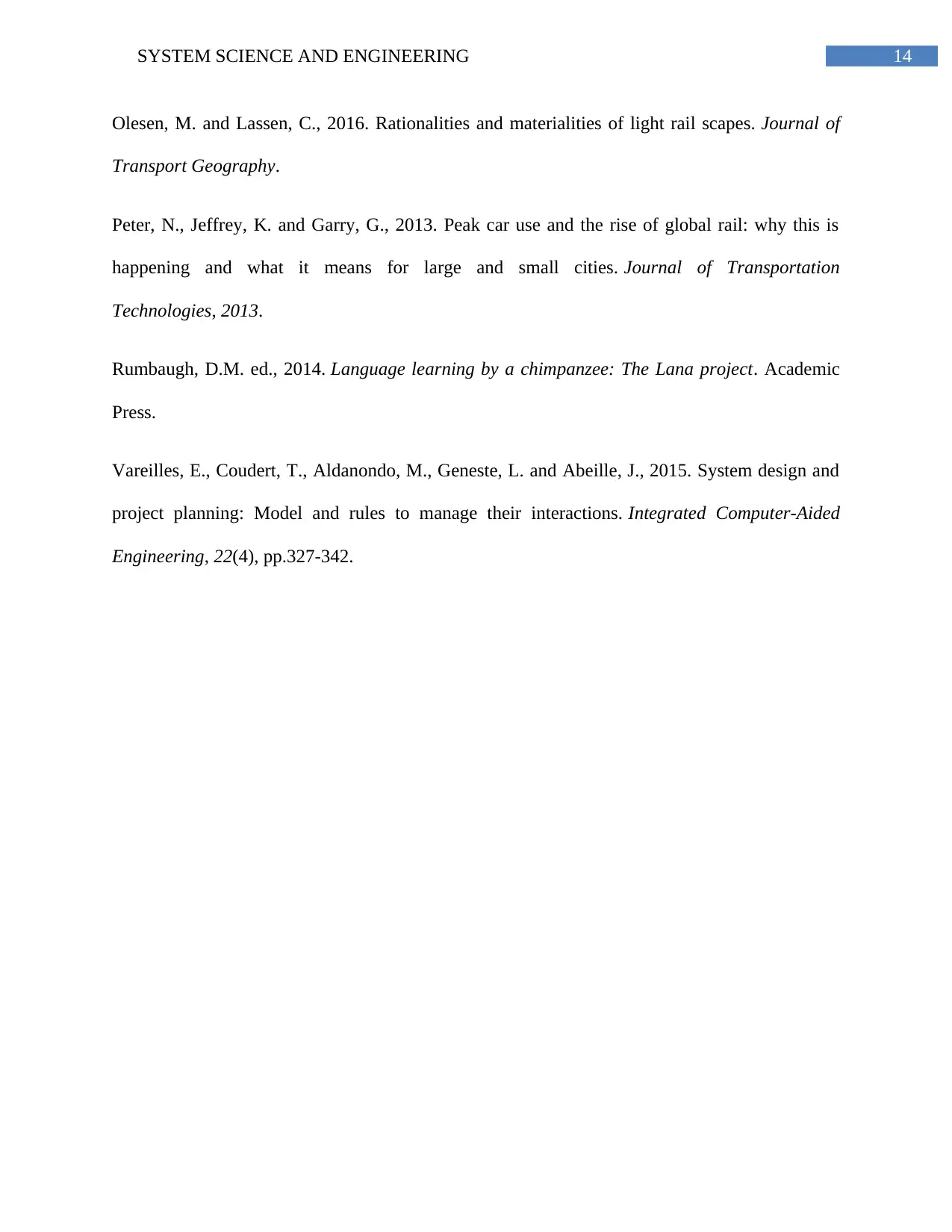
14SYSTEM SCIENCE AND ENGINEERING
Olesen, M. and Lassen, C., 2016. Rationalities and materialities of light rail scapes. Journal of
Transport Geography.
Peter, N., Jeffrey, K. and Garry, G., 2013. Peak car use and the rise of global rail: why this is
happening and what it means for large and small cities. Journal of Transportation
Technologies, 2013.
Rumbaugh, D.M. ed., 2014. Language learning by a chimpanzee: The Lana project. Academic
Press.
Vareilles, E., Coudert, T., Aldanondo, M., Geneste, L. and Abeille, J., 2015. System design and
project planning: Model and rules to manage their interactions. Integrated Computer-Aided
Engineering, 22(4), pp.327-342.
Olesen, M. and Lassen, C., 2016. Rationalities and materialities of light rail scapes. Journal of
Transport Geography.
Peter, N., Jeffrey, K. and Garry, G., 2013. Peak car use and the rise of global rail: why this is
happening and what it means for large and small cities. Journal of Transportation
Technologies, 2013.
Rumbaugh, D.M. ed., 2014. Language learning by a chimpanzee: The Lana project. Academic
Press.
Vareilles, E., Coudert, T., Aldanondo, M., Geneste, L. and Abeille, J., 2015. System design and
project planning: Model and rules to manage their interactions. Integrated Computer-Aided
Engineering, 22(4), pp.327-342.
1 out of 15
Related Documents
Your All-in-One AI-Powered Toolkit for Academic Success.
+13062052269
info@desklib.com
Available 24*7 on WhatsApp / Email
![[object Object]](/_next/static/media/star-bottom.7253800d.svg)
Unlock your academic potential
© 2024 | Zucol Services PVT LTD | All rights reserved.





